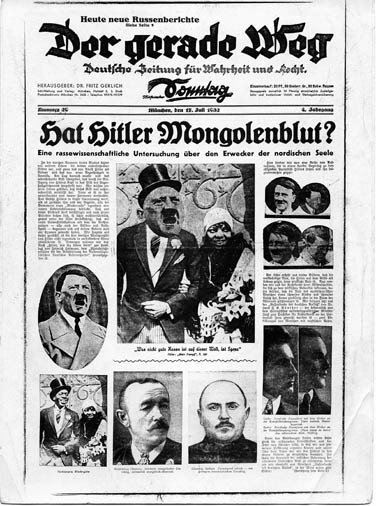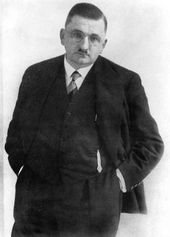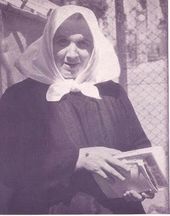The heroic anti-Hitler Munich journalists who, from 1920 to 1933 (when many were jailed or murdered) bravely went about the daily task of attempting to tell the world about the strange figure who had arisen from the Munich streets to become leader of a movement that would seize power and inscribe a new chapter in the history of evil. My fascination with these largely forgotten figures, the reporters who were the first to investigate the political and personal life, the criminality and scandals of Hitler and "the Hitler party," as they astutely called it, began to grow as I first began to pick up echoes and traces of their struggle with Hitler, buried in the footnotes of postwar historians...Rosenbaum sees the cruel gesture as, perhaps, an acknowledgment by Hitler's thugs that Gerlich had seen too much and knew too much, "a token of how much his vision was feared and hated by the Hitler inner circle, for having seen through them."
My fascination deepened when I came upon a nearly complete collection of flaking and yellowing, seven-decades-old back issues of the anti-Hitler Munich Post, moldering away in the basement of Munich's Monacensia library archives. They've since been transferred to microfilm, but there was something about communing with the actual crumbling copies of the newspaper Hitler's party called "the Poison Kitchen," issues in which Hitler was a living figure stalking the pages, that served to give me a painfully immediate intimation of the maddeningly unbearable Cassandra-like frustration the Munich Post journalists must have felt. They were the first to sense the dimensions of Hitler's potential for evil - and to see the way the world ignored the desperate warnings in their work.
As a journalist, I felt simultaneously a growing awe at what they'd accomplished, how much they'd exposed, and how completely they'd been forgotten. Theirs was the first sustained attempt to fathom the depths of the Hitler phenomenon as it began to unfold....
The vision of the First Explainers was the vision of the men and women who were critical witnesses to the now-lost spectacle of Hitler becoming Hitler. In addition to the courageous reporters and editors of the Munich Post, there were others such as Rudolf Olden, Konrad Heiden, Walter Schaber... and Fritz Gerlich. The iconoclastic editor of a conservative anti-Marxist, anti-Nazi opposition paper called Der Gerade Weg (The Right Way, or Straight Path), celebrated as a journalistic nemesis of Hitler in his time, largely forgotten now.
Gerlich was murdered in Dachau for attempting to print a damaging expose of Hitler five weeks after the Nazis had seized power and crushed the rest of the opposition press. A fascinating figure, Gerlich, a scathing Swiftian satirical scourge of Hitler, he possessed an uncanny insight into the racial dynamics of Hitler's pathology. A skeptical historical scholar, Gerlich nonetheless came to believe in the prophetic powers of a controversial, probably fraudulent, Bavarian stigmatic and found in her a source of the faith that led him to gamble his life on a last-ditch effort to bring Hitler down with his pen and printing press. With an expose to end all exposes of Hitler, he hoped: one final story that would shock the public and cause President Paul von Hindenburg to depose the newly installed Chancellor Hitler before it was too late. It was a desperate gamble that failed.
On March 9, 1933, storm troopers burst into Gerlich's newspaper office, ripped his last story from the presses, beat him senseless, and dragged him off to Dachau, where he was murdered on the Night of the Long Knives in June 1934. The nature of the expose he'd been about to publish - some said it concerned the circumstances of the death of Hitler's half-niece Geli Raubal in his apartment, others said it concerned the truth about the February 1933 Reichstag fire or foreign funding of the Nazis - has been effectively lost to history; it is one of the evidentiary trails I've pursued to the bitter end. ...
I managed to track down in Munich one of Gerlich's last living colleagues, Dr. Johannes Steiner, a retired publisher in his nineties who had been a partner in Gerlich's doomed anti-Hitler attack sheet, Der Gerade Weg. Dr. Steiner's memory of that awful time, particularly the last days of Gerlich, when they were all on the run, was fragmentary. But there was one moment, one memory he'd preserved with frightening clarity for six decades: a memory of the Gestapo and Fritz Gerlich's spectacles. Gerlich's steel-rimmed glasses had become a kind of signature image for the combative newspaperman among those who knew him in Munich, an emblem almost of his steely determination and clarity of vision. But after a year in Dachau, after the Gestapo had dragged him out of his cell and shot him in the head on the Night of the Long Knives, Hitler's thugs chose a cruel and chilling way to notify Gerlich's wife. Dr. Steiner recalled: "They sent to his widow, Sophie, Gerlich's spectacles, all spattered with blood." [Ron Rosenbaum, Explaining Hitler]
Now, did you notice anything particularly interesting in the above, brief account of the who, what, when, and where of Fritz Gerlich? It probably slipped right by, but it was this: "A skeptical historical scholar, Gerlich nonetheless came to believe in the prophetic powers of a controversial, probably fraudulent, Bavarian stigmatic and found in her a source of the faith that led him to gamble his life on a last-ditch effort to bring Hitler down with his pen and printing press." What is Rosenbaum talking about? A "Bavarian stigmatic"?
Well, before we get to that, let's talk about Fritz Gerlich and "The Trial of Hitler's Nose." In July of 1932, an extraordinary photocomposite image of Hitler appeared on the front page of one of Munich's leading newspapers. I tried, without success, to obtain an image of this issue - but a reader found it:

The photo shows Hitler in top hat and tails, arm in arm with a black bride in a wedding scene and the headline read: "Does Hitler Have Mongolian Blood?" It seems that caricatures of Hitler had appeared in many of the opposition papers and on posters for years, but most of these tended to focus on the mustache and forelock or facial exaggeration. This image struck much closer to home and certainly was Gerlich's death warrant. To publish an attack as vicious as this one, an attack that was more far reaching and deeply wounding in the body of the text than even the sensational photo and headline would indicate, was an act of great personal courage by a desperate and doomed prophet. In his hitpiece, Gerlich proposes that the reader apply the "racial science" of one of Hitler's favorite racial theorists, Dr. Hans Gunther - who had prescribed the precise shape and dimension of each and every head and facial feature of "the Nordic type" - to Hitler's own head and face, especially to his nose. With accompanying photographs, Gerlich proceeds to demonstrate that Hitler was not, in fact, Aryan, but was, rather, of the Mongolian type. Gerlich went further in writing a "brilliant critique which resulted in the devastating conclusion that Hitler - by his own lights - not only lacked Aryan physiognomy, he lacked an Aryan soul." Rosenbaum writes:
[It gave] great satisfaction that at least here, one anti-Hitler journalist had gone all out, had gone for the jugular, had given vent to the anger and contempt that all felt before they were all silenced. I suspect this no-holds-barred fatal recklessness has something to do with my own fascination with Gerlich. It's surprising to discover, when you look at the literature on Hitler and the Nazi leadership before and after the war, inside and outside Germany, how little outright, heartfelt hatred and loathing is expressed in print. The tone and tendency of prewar explainers was to condescend to Hitler, to treat him as a phenomenon beneath contempt, much less serious consideration. Rather than urge the necessity of combating Hitler, prewar explainers acted as if he could be wished away with words, belittled into oblivion. They diminished him to the point where he was not even a worthy target for antagonism.So, Ron Rosenbaum has found a heroic standard bearer in the life and work of Fritz Gerlich; but he has a problem. He says that Gerlich was "driven by his obsession with Hitler from the rational to the irrational..." Why does he see the man who performed such acts of journalistic resistance against Hitler - acts that he admires so much, even right to the end, as "irrational"? It's the problem of the "Bavarian Stigmatic" which I'm getting to; be patient.
Postwar literature tends to diminish Hitler in a different way; knowing well what he wrought, the tendency is to argue it wasn't really him, it was the deeper and more profound forces behind and beneath him, the wave on which he rode.... The rare exception to it like Gerlich throws the absence of passion elsewhere into stark relief. ...The reckless yet exquisitely well-honed hatred beneath the surface of Gerlich's satire ...was more than a howl, it was a razor-edged analytic tool that cut to the heart of Hitler's pathology before anyone else did, before it was too late - if anyone had listened. [Ron Rosenbaum, Explaining Hitler]
Fritz Gerlich was born Protestant and received a doctorate in history at university in Munich. By 1923, he was a respected and influential figure in the nationalist movement and was, therefore, an early supporter of Hitler. However, in the spring of 1923, he received a visitor in his apartment, that rising star of the right-wing nationalist forces, Adolf Hitler himself. No one knows what happened at that meeting, but it seems that something said then, connected with things Hitler did later, turned Gerlich into an implacable foe. Apparently, Gerlich had seen something, the "two faces of Adolf Hitler."
Gerlich formed a close-knit group of colleagues who all worked first at the Munchener Neueste Nachrichten, and then later, with Gerlich on his own spinoff anti-Hitler paper, Der Gerade Weg. For ten years, from 1923 until 1933, this group was the most outspoken center of anti-Hitler journalism among conservatives in Germany. The Gerlich group members who escaped arrest in the raid on the paper in March of 1933 went on to become the nucleus of the anti-Hitler movement that culminated in Claus von Stauffenberg's failed assassination attempt on Hitler in July of 1944. As you might guess, at that point, they were executed.
We go to Rosenbaum now to learn about Gerlich and Neumann:
But something strange happened to Gerlich and this little group in the late twenties: They forged a highly improbable alliance, one that became a source of the faith that fueled their courageous anti-Hitler campaign. Gerlich and his friends became deeply involved with a holy stigmatic - a highly controversial, probably fraudulent, yet widely worshiped Bavarian woman: Therese Neumann. It still seems remarkable to me that a skeptical, Protestant, rationalist historian such as Gerlich, the no-nonsense newspaper editor with the gimlet eye behind the steel-rimmed glasses, would be taken in by this primitive, bedridden, Catholic mystic whose own church was skeptical...Yes indeedy, Rosenbaum's hero was hooked up with a real live "channeler." And Rosenbaum, the rationalist, simply can't bear it. He goes on for some paragraphs assuring us that Therese Neumann was a fraud, a charlatan, and undoubtedly it was something wrong with Gerlich's mind that led him into this nonsense, never mind that he continued to do excellent work, and was, in fact, among the bravest of those journalists that stood against Hitler. More than this, it seems that the channeler was literally the inspiration for much of Gerlich's work, and Rosenbaum turns impressive cerebral cartwheels trying to talk his way around that! Now, how can that be? Rosenbaum can hardly stomach it.
One of [Therese's] visitors - an aristocratic Catholic conservative, Count Erwin von Aretin, who survived to become Gerlich's postwar biographer - became a believer.... Finally, after repeated urgings from his colleagues, the skeptical Protestant Gerlich decided to pay a visit to the stigmatic. To the surprise of just about everyone, he came back deeply impressed. More than that, he returned repeatedly, found himself drawn deeper and deeper into the peasant girl's circle, would transcribe her visionary utterances, and translate them into warnings and prophecies about the growing crisis in Germany. ... Dr. Johannes Steiner, Gerlich's colleague, portrays Gerlich first going to Konnersreuth "determined to unmask every fraud he encountered... If there were any to be found." [Ron Rosenbaum, Explaining Hitler]
As it happens, it seems that Therese Neumann was NOT a fraud:
Wonder or fake-investigations in the case of the stigmatisation of Therese Neumann von Konnersreuth.What is certainly true is that Therese Neumann, a channeler, was the inspiration behind one of the bravest journalists in Germany during the times in which Hitler rose to power. Even after Gerlich's murder in Dachau, the circle around Therese Neumann continued their participation in the morally significant resistance to Hitler. It was the mystical source of Gerlich's strength that infused his incisive, surgical dissection of Hitler's mentality. And it is this legacy he has left behind for all of us. Throughout history, extending back and back before any written records, people obtained much strength from mystical sources. Such sources came under attack with the rise of materialism. The connection between an emotional knowledge of the world and an intellectual knowledge of the world was snapped. We live under the horrific conditions that are the result of this break. A large part of mankind is now slave to his intellect. The apprehending of the world via the emotions, the intuition, inspiration, which I suggest are the basis for mystical experiences and genuine channeling go outside of the hierarchical structures the rational mind has built to imprison us, be it materialistic science on the one hand or the need to communicate with the divine via priests and other representatives on the other hand. The direct connection with the divine was killed; it had to be killed.
Rolf B, Bayer B, Anslinger K.
Institute of Legal Medicine, Ludwigs-Maximilians-Universitat, Frauenlobstr. 7 a, 80337, Munich, Germany, Burkhard.Rolf@med.uni-muenchen.de.
We investigated two compresses used by Therese Neumann (T.N.), a woman who lived from 1898 until 1962 in Konnersreuth, Germany. The compresses were soaked with blood during the appearance of stigmata on T.N.'s body on a Friday. T.N. became very popular among the faithful in Germany at this time. The question was whether this blood was from T.N. herself or from a family relative or an animal. The comparison of the HV1 and HV2 mtDNA sequence obtained from the compresses with the sequences from a reference sample from a maternally related niece of T.N. revealed an identity. Furthermore, we obtained a short tandem repeat (STR) profile from the bloodstains that were identical with the STR profile from a gummed envelope. The envelope contained a letter written by T.N. in the 1930s. Therefore, our investigations gave no indication for any manipulation.
Dr. Steiner recalled: "They sent to his widow, Sophie, Gerlich's spectacles, all spattered with blood."
We live - and may die - with this legacy.






"Reinhard Lorenz from Meißen (R.L.M.), a medium from the New Salems Society, received a message about Neumann in 1929, allegedly coming from God the Father. It was published in "Das Wort", the periodical of the movement. It is said that the startling phenomenon of Konnersreuth is approved by God to be an impact that can't be argued away. Science will not be able to make out how the wonder happened and persist. Everyone should look into his heart for understanding and this will create various useful thoughts to understand the signs of the times. Because they consider it ungodly and amiss, some want dictate to God what to do, but God does what he wants and will achieve his goal at last. Blessed is he, who not gets annoyed at God.[13]"
"According to Paramahansa Yogananda, Therese Neumann said during his visit: "One of the reasons I am here on earth today is to prove that man can live by God's invisible light, and not by food only." His judgement was: "I realized at once that her strange life is intended by God to reassure all Christians of the historical authenticity of Jesus' life and crucifixion as recorded in the New Testament, and to dramatically display the ever-living bond between the Galilean Master and his devotees." When Paramahansa Yogananda questions the notion that Therese Neumann had lived eating only a daily eucharistic wafer for the past 12 years, she states that she lives by God's light. The renowned yogi then suggests, "I see you realize that energy flows to your body from the ether, sun, and air." Therese then smiles and expresses her happiness that he understands the way she lives.[14]"